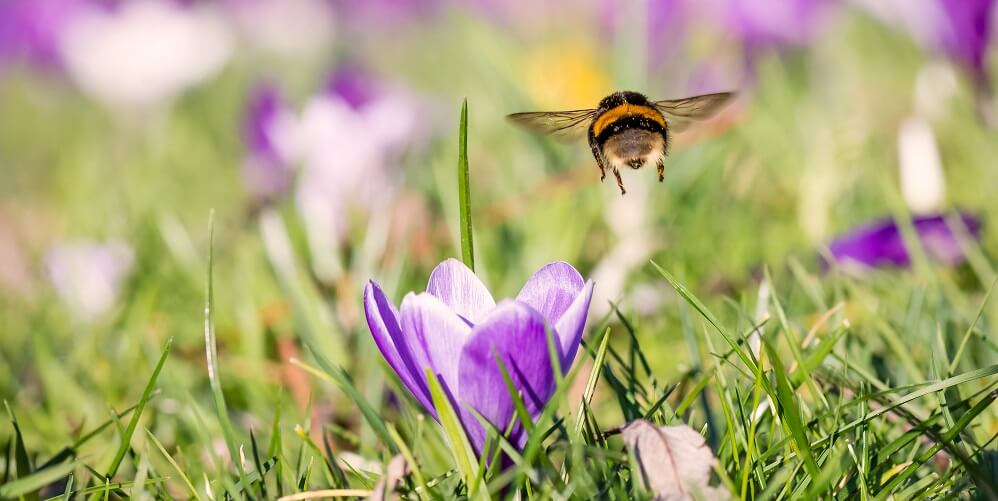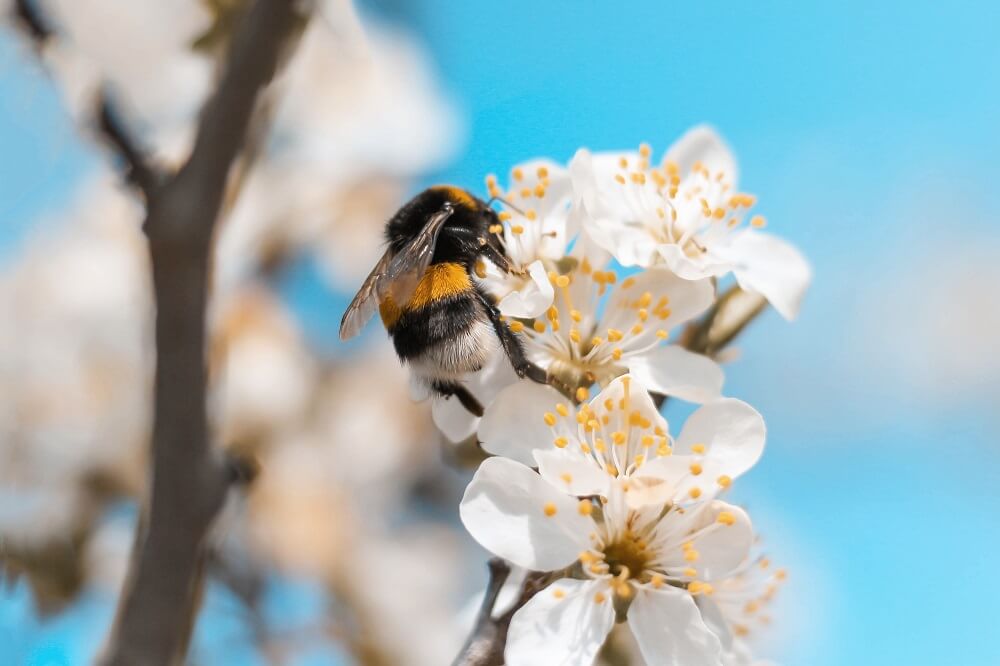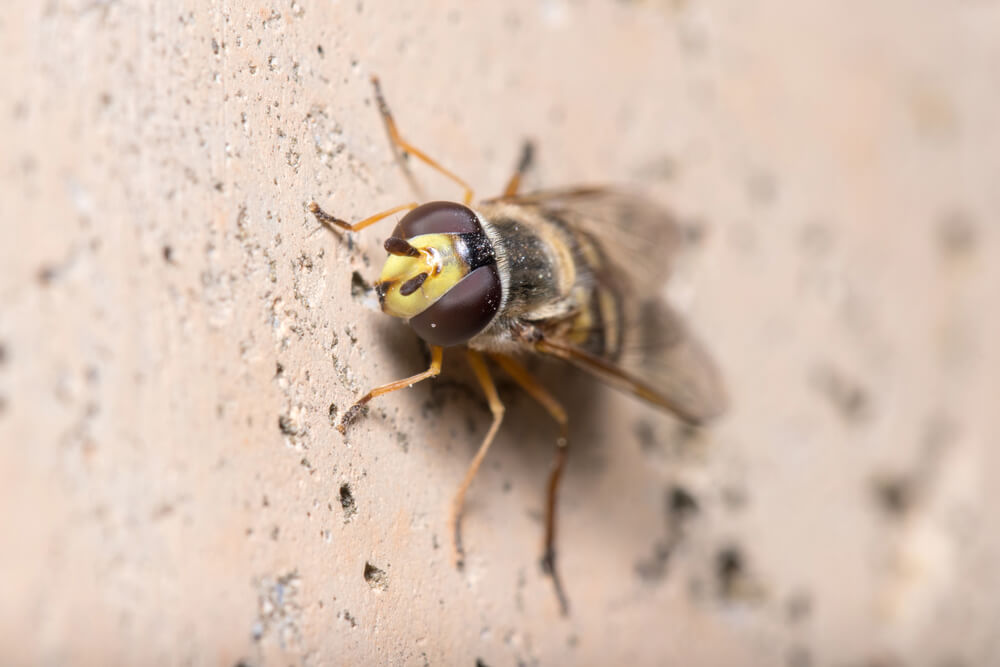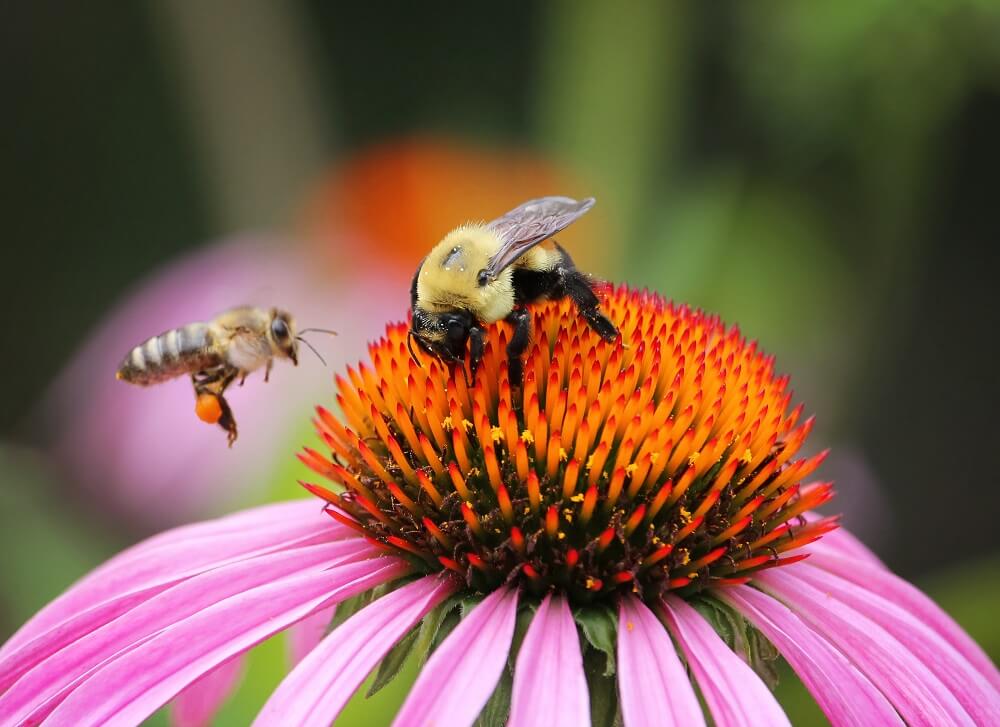Table of Contents:
What Do Bumble Bees Eat and Drink?

Short answer:
Bumblebees drink water and eat pollen and nectar from flowers.
But how do they do it?
For starters, bumblebees get water from puddles, ponds, and dew they find on flowers or grass.
For food, they use their long tongues to reach the nectar deep inside flowers. Bumblebees also collect pollen on their fuzzy bodies while they’re sipping nectar. As a result, the bumblebees pollinate the flowers they visit by leaving a little pollen behind each time.
Check out this bumblebee covered in pollen:

Pretty cute, right?
But bumblebees are more than just cute, fuzzy, and gentle-natured bees. They give us the gift of pollination. These busy bees work from sunup to sundown, collecting and dispersing pollen on flowers.
And believe it or not:
Native bees like bumblebees are estimated to pollinate 80% of flowering plants.
To take it a step further, fruit crops like cherries, blueberries, and cranberries rely on bumblebees, honeybees, and others for pollination. Even self-pollinating crops like cotton and soybeans have a higher yield with the help of pollinators.(1, 2)
And the good news?
Bumblebees are gentle bees. They rarely sting unless you’re poking around their nest or trying to grab them. Plus, they’re valuable assets to your gardens or flower beds.
Now you might be asking:
What Can I Feed Bumble Bees?

Simple.
Start by planting a bee-friendly garden.
Even if you have a small yard, you can plant flowers in containers to grab bees’ attention. Bumblebees are attracted to plants like lavender, catmint, oregano, New England asters, and salvia. Your yard will become a bumblebee magnet if you plant these flowers.
You might also find that bumblebees (and other bees) are attracted to your hummingbird feeders.
But here’s the thing:
Bumblebees will eat sugar water as a last resort if nectar sources are low in your area.
More importantly?
Allowing bees to drink from your hummingbird feeders won’t make them lazy. This is a common myth. If plenty of blooming flowers are available, the bees won’t even touch your hummingbird feeders.
Bumblebees drink from hummingbird feeders as a last resort to help feed themselves, their queen, and their baby bees.
So how can you help?
The absolute best thing to do is plant a bee-friendly garden. This includes a mixture of flowers that bloom in the early spring, summer, and late fall.
But what about sugar water?
Yes, you can offer sugar water to bumblebees. But keep in mind that your sugar water might also attract honeybees, which is fine. They’ll only use it when they really need it, such as during the heat of the summer. During this time, flowers can wilt or die due to excess heat and lack of moisture.
That said, there are a few tips you should follow first:
Tip 1: Use Hummingbird Feeders or Bee Feeders
Bumblebees can’t swim, so they’ll drown if you leave the sugar water in an open container. They need safe places to perch on, so they don’t fall in the sugar water.
Hummingbird feeders or bee feeders are the easiest things to use.
Tip 2: Use a 1:1 Sugar Water Ratio
Mix one part white sugar with one part water. Only use white table sugar – not brown sugar or confectioners sugar. Stir the mixture until the sugar dissolves.
Tip 3: Tint Your Sugar Water With Blue or Green Food Coloring
Use plant-based food coloring to do this.
Why is this important?
Because your bee feeders will most likely attract honeybees as well. This is fine since bumblebees and honeybees coexist peacefully together.
That said, the honeybees may belong to a local beekeeper. And the honeybees will fill their honeycombs with your sugar-water mixture. But beekeepers only want pure honey – not sugar water.
So tinting your sugar water with food coloring will also tint the honey cells. This alerts the beekeeper to the fact that it’s sugar water instead of honey.
Tip 4: Clean Your Feeders Weekly to Prevent the Spread of Bacteria
It’s worth mentioning:
Most types of feeders need regular cleaning. This includes bee feeders, hummingbird feeders, and regular bird feeders that hold seeds.
Here’s what you do:
Take your feeders apart once or twice per week and soak them in bleach water. Allow them to soak for 15 minutes in a mixture of 1 cup bleach with 10 cups of hot water. Next, wash them well with soapy water, rinse well, and refill them.
Tip 5: Don’t Forget About Water
Bees need to drink too.
But remember:
Bees can’t swim, so they’ll need landing perches to rest on while they sip the water safely. I recommend filling a shallow birdbath with rocks, marbles, or crystals. Next, pour water over the landing perches but make sure the perches remain above the waterline.
And finally, clean your bee waterer regularly too.
Do Bumble Bees Eat Honey?

Yes, bumblebees make and eat their own honey.
But how does bumblebee honey compare to that of honeybees?
They taste similar, but their quantities differ greatly. For one, bumblebees only make a few tablespoons of honey. It’s just enough to feed their colony of 50-500 bees.
In contrast, a healthy honeybee colony can make up to 100 pounds of honey per year. This is because honeybees have large hives consisting of up to 60,000 bees. That’s a ton of mouths to feed.
But one important note:
You should never feed bumblebees (or other bees) honey. Bumblebees should only eat the honey that they produce. Honey from other hives can introduce deadly diseases and bacteria to their colony.
Not good.
FAQs About “What Do Bumble Bees Eat?”
- What do bumblebees eat in winter?
- What do bumblebees eat when there are no flowers?
- Do bumblebees like honey?
- Do bumblebees drink water?
- Do bumblebees eat fruit?
- What do black bumblebees eat?
- Do bumblebees eat wood?
- Do bumblebees eat other insects?
- How often do bumblebees eat?
- What do bumblebee larvae eat?
What do bumblebees eat in winter?
Bumblebees don’t eat during winter because most of the colony dies before then. Only the queen bumblebee survives, and that’s because she hibernates.
The queen hibernates until spring, and neither eats nor works during that time. She survives the winter because her body burns little fuel due to her depressed metabolic rate.
—> Go back to the FAQs on “Bumblebees Food: What Do Bumble Bees Eat?”
More to Explore:
What do bumblebees eat when there are no flowers?
When there is a nectar dearth, bumblebees will eat their own honey. The colony can be put at risk of starvation if there isn’t enough honey or flowers available.
Nectar dearths frequently happen during the hot summer months with little to no rainfall. The flowers start to wilt, and the bees will have fewer nectar sources.
If you want to learn how to feed bumblebees, I recommend planting drought-tolerant flowers. Drought-tolerant flowers include:
You can also feed bumblebees (and other bees) a 1:1 sugar-water mixture. Follow our tips outlined here to do so.
—> Go back to the FAQs on “Bumblebees Food: What Do Bumble Bees Eat?”
More to Explore:
Do bumblebees like honey?
We get asked this frequently, along with other questions like:
Do bumblebees eat honey? What do bumblebees eat in the wild? What food do bumblebees eat? What do bumblebees like to eat?
Yes, bumblebees make honey for food storage. But unlike honeybees, bumblebees don’t make large amounts – usually only a few tablespoons per hive.
So, in a nutshell, a bumblebee’s main diet is pollen and nectar. But bumblebees also supplement their diet with a small amount of honey when needed.
With that in mind, you should never feed bumblebees honey. Honey from the grocery store comes from other beehives. Bees should only eat the honey they make for their colony. Honey from other colonies can contain bacteria that are deadly to bumblebees.
—> Go back to the FAQs on “Bumblebees Food: What Do Bumble Bees Eat?”
More to Explore:
- Ground Bees: Are They a Threat to Your Yard?
- Wasps vs. Honeybees: Are They Different?
- Do Bumble Bees Bite?
Do bumblebees drink water?
Yes, bumblebees need water to survive just like humans do.
Bees get water from various natural sources, including dew on leaves or flowers, puddles, damp rocks, or pond edges.
Some people (especially beekeepers) will provide fresh water for bees. If you want to help bumblebees, I recommend filling a shallow birdbath with fresh water and adding rocks or marbles. The marbles or rocks act as landing perches to give the bees a place to safely land without drowning.
Don’t forget that bees can’t swim, so landing perches are a must. Just make sure the waterline doesn’t go above the rocks or marbles.
—> Go back to the FAQs on “Bumblebees Food: What Do Bumble Bees Eat?”
More to Explore:
Do bumblebees eat fruit?
Yes. During nectar dearth, bees will start eating ripe fruit such as peaches, apples, and pears. This is because ripe fruit is sweet enough to attract bumblebees.
So people often ask:
Do bumblebees eat human food?
Yes, but ripe fruit and sugar from sugar water are the only human foods bumblebees will eat.
—> Go back to the FAQs on “Bumblebees Food: What Do Bumble Bees Eat?”
More to Explore:
- Do Carpenter Bees Pollinate?
- How Long Do Bumble Bees Live?
- Honeybees vs. Bumblebees: How Do They Compare?
What do black bumblebees eat?
Fun fact:
There are over 250 species of bumblebees.
So people often ask things like:
What do rusty patched bumblebees eat? What do giant bumblebees eat? What do baby bumblebees eat? What do queen bumblebees eat?
Bumblebees, regardless of their species, eat pollen and nectar from flowers. Bumblebees sip the nectar using their long tongues and store the pollen in special “pollen baskets” on their hind legs.
Pollen is a protein-rich food source that bees use to feed their young. Nectar is a sweet substance that provides bees with the energy needed to get around.
Bumblebees will also eat honey when nectar is scarce.
—> Go back to the FAQs on “Bumblebees Food: What Do Bumble Bees Eat?”
More to Explore:
Do bumblebees eat wood? Can bumble bees eat through wood?
No, bumblebees don’t eat wood.
People ask this because bumblebees resemble carpenter bees. Carpenter bees make their nests by drilling into wood.
But despite common belief, carpenter bees don’t eat wood either. Instead, carpenter bees eat pollen and nectar like other types of bees. They just drill into wood with their jaw (mandibles) to make nests.
Unlike carpenter bees, bumblebees don’t drill into wood for nesting. They make their nests by finding existing holes such as those made by other animals or birds. So if you see a bee going in and out of a hole in wood, it’s most likely a carpenter bee and not a bumblebee.
—> Go back to the FAQs on “Bumblebees Food: What Do Bumble Bees Eat?”
More to Explore:
Do bumblebees eat other insects?
“Do bumblebees eat spiders?” and “Do bumblebees eat bugs?” are common questions we get.
No, bumblebees don’t eat insects. Bumblebees eat pollen and nectar from flowers.
And you know what?
Bumblebees are actually important pollinators of crops such as cranberries and blueberries. That’s why farmers like having bumblebees around.
People often mistake bees for wasps. Wasps do eat insects, so this is what gets people confused. Keep in mind that wasps and bees are two totally different insects with different lifestyles, temperaments, and eating and nesting habits.
—> Go back to the FAQs on “Bumblebees Food: What Do Bumble Bees Eat?”
More to Explore:
How often do bumblebees eat?
It’s tough to say what time intervals bumblebees eat on. What I can say, however, is that bumblebees work from daylight till dawn collecting pollen and nectar. They bring it back to their hive, sharing it with their colony members.
—> Go back to the FAQs on “Bumblebees Food: What Do Bumble Bees Eat?”
More to Explore:
What do bumblebee larvae eat?
Like adult bumblebees, larvae also eat pollen and nectar. Pollen is their protein source, and nectar is their carbohydrate source.
Bumblebees feed the baby bees nectar by chewing a tiny hole in the brood cell and regurgitating nectar into it.
Depending on the bumblebee species, pollen is fed one of two ways:
Some bumblebee species make pollen pockets at the base of the brood cell. Then the larvae feed themselves from these pollen pockets.
Other bumblebee species store the pollen in wax pots and feed it to the larvae.
—> Go back to the FAQs on “Bumblebees Food: What Do Bumble Bees Eat?”





